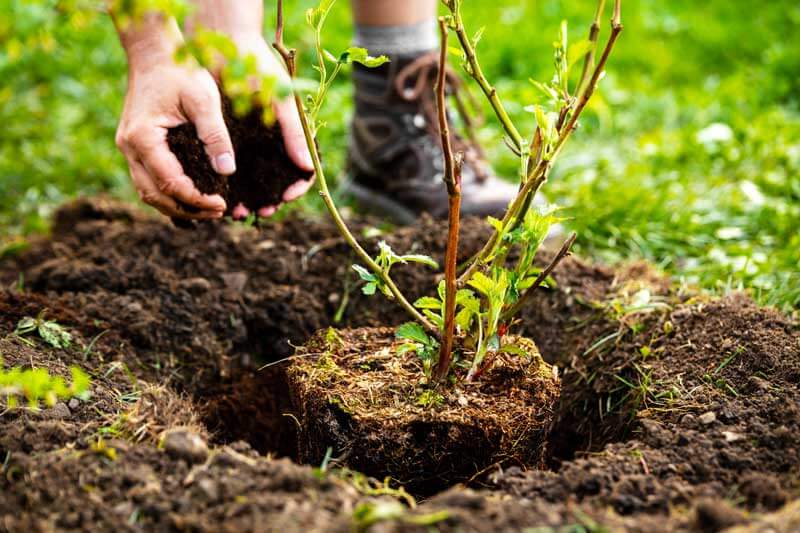How to plant a tree or shrub –

What You Will Need
To properly establish your new tree or shrub you will need:
TREES
- Transplanting Fertilizer (Bonemeal)
- Compost
- Tree Stake
- Tree Tie
SHRUBS
- Transplanting Fertilizer (Bonemeal)
- Compost
What is transplanting fertilizer?
The first thing plants need to after planting is to establish their root system, Transplanting fertilizer are high in phosphorus, which is the middle number. A great natural fertilizer is bone meal.
DIGGING THE HOLE
Planting too deep is the top reason that trees and shrubs die. Follow these simple steps to ensure the correct planting depth for both ball and burlapped (B&B) and potted trees:
- Locate the point at which the truck flares out to join the roots. On B&B trees, remove the twine and burlap at the base of the truck. If necessary, gently push the soil away from the base of the trunk to find the flare.
- Measure the distance from the bottom of the root mass to the trunk flare. Dig hole no deeper than this; you want the root mass to sit on undisturbed soil. When planting is complete, the trunk flare should be slightly above the existing soil grade.
- Dig the hole two to three times the diameter of the root ball or container, sloping the sides gently outward to the existing soil grade.
BACKFILL MIX
Modify the existing soil taken out of the hole with a small amount of compost approximately ¼ compost to ¾ soil. Add some bonemeal to this mixture, approximately 2 handfuls. Do not fertilize the first year.
PLANTING THE TREE OR SHRUB
B&B Trees and shrubs
- Place the tree in the center of the hole. If necessary, straighten or stabilize the tree by adjusting or filling beneath the root ball with the backfill mix.
- Cut away any twin or burlap from the base of the trunk and remove any burlap that is on the top of the root ball. Remove excess soil from the top of the root ball to expose the trunk flare, if needed.
- Use bolt cutters to remove as much of the wire basket as possible. Don’t try to remove the entire wire basket. Remove all the rope and twine from the root ball, as well as any nails holding the holding the burlap together. Pull back the burlap and cut away any loose material. It’s OK to leave some burlap in the hole.
Potted Trees and Shrubs
- Tip the container on its side and slide the plant from the container. Place the plant in the hole by lifting the root mass, not the plant itself. If the plant has become pot-bound, it may be necessary to cut the container before the plant can be removed.
- To encourage root growth, tease the outer roots from the soil. If the roots are tightly matted, use a knife to score the root mass in several places and gently loosen the root ball. This won’t harm the plant and will encourage new root growth.
BACKFILLING AND WATERING THE PLANTING HOLE
- Add the backfill soil to your planting hole until it comes about halfway up the root ball. Use your foot or hands to firm the soil and eliminate air pockets. Make sure the trunk is vertical and confirm that the trunk flare will sit slightly above soil grade, once backfilling is complete. Continue adding backfill and packing it down until you’ve reached the top of the root ball, taking care not to cover the trunk flare.
- Construct a 3”-4” high ridge of soil around the outer edge of the planting hole. This berm will create a basin to hold water and concentrate it over the roots. Fill the basin with water to soak it, repeating several times. The goal is to ensure even watering so the soil is drenched and any large air pockets are eliminated.
- Recheck that the trunk flare is completely exposed and the top of the root ball has not been covered with additional soil.
MULCHING
Apply bark mulch to a depth of 2”-3” over the entire planting hole. Mulching helps conserve water and prevents weeds. Taper the mulch toward the base of the tree, but do not allow it to touch the tree trunk.
STAKING
Newly planted trees should be staked, shrubs normally do not require staking.
FERTILIZING
We do not recommend fertilizing newly planted trees or shrubs during their first year of growth.
What Should I expect? Sleep-Creep-Leep
After transplanting all plants simply want to survive and tend to ‘sleep’ while they establish their root system.
In the second year, while continuing to develop their roots, they will put on a small amount of top growth.
In the third year most trees and shrubs will leap. They will actually become well established plants and put on their expected show.
Please be patient with your new purchase. They will, given time, live up to your expectations.
Delivery in the Saint John area
*cost depending on location.
